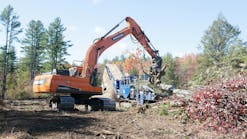Manufacturers suggest grapples should be among the top five attachments in a contractor’s toolbox. But which one should be used when?
To grapple is to move or grasp heavy objects with a hinged device, or as Rusty Schaefer, marketing manager for Case Construction Equipment in Racine, WI, puts it, a grapple allows the contractor to handle “irregularly shaped material.” Savvy contractors should know that grapples can expand the versatility of a variety of base carriers and free up valuable machines for use at other job sites. A grapple in your toolbox can also save money by reducing personnel costs and making the job site safer.
“It takes the right tool to get the job done efficiently and do it job after job after job, for the long run,” says Tom Connor, excavator product specialist for Bobcat in West Fargo, ND. “Contractors need to acknowledge the occasions when they’re trying to accomplish a job with one type of attachment when another one will get it done quicker and easier and without damaging the equipment they’re using.”
“A grapple is an easy, efficient tool,” says Lance Mathern, Bobcat’s marketing director. “Anybody who has spent time being frustrated with trying to get something into their bucket should have a grapple. If you’re doing any kind of breaking up of material, if you’re doing remodeling work and you’ve got to remove material prior to grading, if you’re doing any kind of site prep or land-clearing applications, you’ll want to have a grapple. If you do any kind of retaining wall or rock work, you should have a grapple.”
“Grapples really do change a contractor’s efficiency on a job,” says Renee Zimelis, product support engineer for ACS Industries in Kent, OH. “They can have one machine on the job rather than two because that one machine can do more than one function, and this means they don’t have as much capital investment in each job.”
Yes, but which grapple-a clamshell, tines, a thumb-and-bucket combination, a four-in-one-bucket, or a rotating grapple? For excavators, Mathern thinks a hydraulic clamp-(thumb-)and-bucket combination is a great way to get started grappling. “You put your thumb on the backside of your bucket. And although some operators initially worry the thumb will get in their way, my opinion is that every bucket should be equipped with one. Once you get used to it, the thumb is actually pretty much out of the way for any kind of digging application, and if you run into something when you’re digging footings or a foundation, you have your thumb right there to grab hold of that material and separate it out. Obviously you’ll want to assess the conditions you’ll be working in. In straight sandy conditions you don’t need this kind of attachment, but in almost any other kind of soil you’re likely to find yourself dealing with rocks, tree roots, maybe old construction debris. Being able to pick those materials out and place them out of the way makes the job a lot easier.
“You also get a lot of excavating and grading contractors who do a significant amount of remodeling work. And on any kind of remodeling project when you’re going to use a breaker and then have to pick up and get rid of what you break up, a grapple enables you to pick up those materials and sort them and place them in a dump truck to haul them away.”
It’s important to remember that grapples require auxiliary hydraulics to operate, and Mathern points out that for the most efficient operation and ease of handling, these should be variable-flow, preferably fingertip-controlled hydraulics. “You don’t want your control to be simply on and off, because you don’t want the attachment to smash down on whatever you’re aiming to pick up, whether it’s a rock or a piece of wood. You want to be able to pick it up cleanly. With Bobcat’s attachment you use the thumb control on the joystick to feather the movement of the attachment. This kind of control is so sensitive we’ve had operators pick up a golf ball and place it on a fence post.”
Zimelis likes a tine grapple on excavators to clear woodwaste. “Typically what we’re looking at is four tines on top and three interlacing tines underneath where the thumb would ordinarily be. With this kind of configuration, the grapple works like a hand as opposed to a thumb and bucket, which is more like wearing a mitten. The individual tines allow you to pull up material, and when you’re placing things away from the work area, you have a lot more control-if you have a tub grinder on-site, for example. This kind of attachment also allows you to grasp root balls and shake the dirt out, so you’re not paying to haul dirt and you’re retaining as much of the soil as possible. With the hydraulic force of the grapple you can also crush brush.
“Especially for land-clearing operations, we like to encourage people to think about getting a coupler with a thumb and then a rake in place of a bucket-and-rake combination. They can use the bucket for excavating or clearing, put the bucket down with the coupler and pick up the rake, and have a grapple-type arrangement. We have literature that shows operators how to mix and match, to use the thumb with the bucket for some things and the thumb with the rake for grapple types of operations.”
“This scenario has been fairly well received,” says Mel Schindler, ACS inside sales manager. “People realize they can buy a thumb and put it on the excavator, buy a rake and put it on the excavator, and then use the thumb and rake as a grapple or with a bucket. They don’t necessarily have to take their rake with them every time, and in fact I think they use the thumb with the bucket more frequently. It’s a benefit to their efficiency.
“At ACS we are promoting the idea of purchasing complete attachment packages-whatever the customer needs in the way of couplers, buckets, rakes, thumbs-all in a turnkey package where the components are designed to complement and work with each other. The purchase of a turnkey package also allows a contractor to place one order and receive everything together, which makes installation a lot easier. Parts support and warranty and those kinds of follow-up issues are also a lot more streamlined and efficient. Typically we’ll see a dealer buy a brand A thumb, a brand B bucket, and a brand C rake and try to put them all together. This might be slightly cheaper, but they have more expensive installation time along with support issues, and this leads to rapidly decreasing any dollar advantage from purchasing piecemeal.
“Certainly having the flexibility of having an excavator or a wheel loader coupler-equipped allows a contractor to use tools or attachments that are more efficient at doing specific tasks, and this translates into dollars. If by using correct attachments, we can potentially save a contractor three, four, or five hours a week over the life of a machine, that means a lot for productivity and long-term savings to the bottom line.”
For contractors who need to pick up and place materials with an excavator, a rotating grapple is versatile and cost-effective. “When you’re talking about using a grapple in 80 to 90% of your operations, you’ll want to consider a rotating grapple,” says Connor. “Sometimes known as a clam shell, a rotating grapple is basically two opposing buckets that hydraulically open and close. This function is combined with another hydraulic function that rotates that assembly. Plus, you still have the normal excavator ability to curl or roll an attachment.
“Let’s say a 4×4 is lying perpendicular to your excavator. You can pick that up with the grapple, curl it with your bucket circuit, rotate it with the rotating circuit, and place it directly in a posthole. Or instead of being out there with a crowbar trying to move something like a large boulder around, you can use the rotating grapple to place it just where the landscape architect designed it to be. Granted, the thumb and bucket is a tremendous improvement over hauling something like that in a loader bucket, but this rotating-grapple arrangement gives you the feeling you’re moving whatever it is with your hands. It’s also a valuable offset of labor with a machine.
“Plus, you can also dig with a rotating grapple. In fact, in specific applications a rotating grapple gives you an advantage for digging in that you can dig straight down, where with a backhoe or an excavator you typically have to dig a trench to get a certain depth. The best example I can think of is the homeowner who had water in the inside corner of his basement. One solution was to use an excavator with a trenching bucket, in which case I would probably have had to open up about 10 feet of linear trench to get down to that corner. With the rotating bucket I opened up a trench 18 inches wide, which is the width of the bucket, and the whole length of the trench was probably whatever the opening is, 36 inches. The rotating grapple is very popular in Europe where they want to minimize disruption from construction.”
If a wheel loader is your base carrier, ACS offers a grapple that’s particularly well suited to land clearing, what Zimelis calls a brush rake that allows an operator to do the pick-and-shake routine to get dirt or soil out of whatever is grappled. The tines also allow the grapple to penetrate the soil and sift out rocks and roots and stumps. “Then you use the grapple-arm feature to retain the debris in the rake to load it into a dump truck or burn it, whatever you’re going to do with it. They use the brush rake in Florida to clear out citrus orchards because the trees have fairly shallow root systems.”
For material handling and placement using skid-steers, Bobcat offers both bucket-style and tooth-style grapples. “A general contractor who has to do dirt work, whether it’s backfilling around foundations, hauling pea rock, or anything like that, in a matter of minutes he can drop his bucket and put on the grapple,” says Connor. “We offer probably half a dozen different models of grapple attachments for skid-steer loaders, including a bucket style that has a flat bottom. If you’re handling very small items you don’t want to lose or if you don’t want to leave a path as you’re going from a site to a disposal area, you’ll want to consider a bucket-style attachment. The tined or toothed industrial grapple is great if you want to minimize the amount of dirt, sand, or gravel that you pick up in rubble, which helps reduce the cost of what you’re having hauled away. And it beats a guy driving a skid-steer around with a conventional bucket on it and two other guys chucking in material.
“We see a fair number of grapples on skid-steers being used when contractors have to bust up and remove concrete. You don’t want to use a regular bucket for demolition because you’re going to shorten its life. Pulling and prying at concrete that’s still connected to rebar and chopping the concrete up with the bucket is not something this kind of equipment is made for. Plus, you try to drag material with just a conventional bucket on a skid-steer and you run the risk of the material falling out. With a grapple you close it and you’ve secured the load.”
“A skid-steer in a grading and excavation operation is a machine with a lot of versatility,” says Schaefer. “In order to expand that versatility, you may have to handle irregularly shaped objects, and a scrap grapple for this kind of machine can do it much faster, much more efficiently than a regular dirt bucket. I’m not saying you won’t be able to pick up a stump in a dirt bucket, but with a grapple you can move it much faster. And many times using a grapple eliminates hand labor, and this is safer and more cost-effective.” Like other equipment manufacturers, Schaefer also recommends a four-in-one bucket, which won’t handle the capacity of a scrap grapple but will in fact move stumps or logs or concrete. “A dirt bucket would be good for hard-packed or granular material,” says Schaefer. “But a four-in-one bucket will handle job cleanup as well as irregular objects like stumps and logs.”
Mathern agrees. “Your combination bucket is very, very popular. Let’s say you’re doing initial site cleanup prior to grading and you’ve got piles of sticks and debris. If you’ve ever tried to push that with a bucket-tried to roll debris into your bucket-you know it can be almost impossible.”
If contractors can’t get what they want to fit their application off the shelf, manufacturers also specialize in custom grapples. Dave DeWeese of Werk-Brau Company in Findlay, OH, estimates 40% of the grapples his company sells are customized in some way-“either extra openings, larger capacity, or the fact that they have lifting rings attached to them so not only can you tear apart something or move something, you can move new product in place.”
Aside from application, what else do contractors need to consider when they’re thinking about buying a grapple attachment? First, according to Sara Bemowski at CEAttachments in Cedarburg, WI, whatever you select should come equipped with a dual hydraulic system. This allows operators to handle uneven loads. Second, be aware of exactly what you’re going to be using the grapple for. “My suggestion,” says Bemowski, “is the 80/20 rule. If 80% of the time you’re going to be needing to pick up dirt and therefore need a solid bottom on the grapple bucket, go with that. If 80% of the time or something close to that you would need something with an open bottom, that would be more on the lines of an industrial grapple. My best advice is once you have established that you need some kind of grapple, talk to the equipment dealer to see what they would suggest for the equipment the attachment is going to be used with. If it’s going to be a really big loader, you’re not going to want to put something like a utility fork on it because in no time the tines are going to be bent. At the same time, an industrial grapple on a small loader isn’t going to handle all that well.” Connor also cautions against using, in an industrial setting, a lightweight utility grapple like the one Bobcat sells for agricultural applications. “There is no way a utility grapple has the integrity of an industrial grapple.”
If you buy a grapple from an independent manufacturer, be sure it will fit whatever equipment you plan to use it with. “At Werk-Brau we make several different classes of tines based on the machine type,” says DeWeese. “The idea is to match the OEM [original equipment manufacturer] specifications as far as lifting capacity, hydraulic capacities, and rotation, which is why we have probably 20% more classes than anyone else out there. Our products are designed to maximize the performance of the host machines. If it’s a John Deere 200, it’s going to be a different grapple than what you would be using on a John Deere 300.”
Decide how efficient you want your machines to be. “The contractors who want to use their machines as tool carriers,” says Ryan Murphy of INDECO North America in Stratford, CT, “are spending money on quick couplers because they’re looking for versatility. They want to be able to switch between various attachments easily. What a coupler does is allow you to keep pins in all your attachments and hook an attachment up to the hydraulics. You just drive over and pick it up.”
Manufacturers insist there isn’t a lot of learning involved in using grapples effectively, and Rick Longstaff of Vista Training in Burlington, WI, says there’s currently no call for this kind of specialized training. “I’ve never known OSHA to cite something specific to a grapple,” says Longstaff. “They would site something specific that happened when a grapple was being used by citing the general training requirement rule that the employer has to train employees how to operate the equipment they’re using. But anytime someone doesn’t understand the basic operation of a piece of equipment, they can create dangerous situations very quickly. With a grapple, for example, you sometimes have center-of-gravity issues. Let’s say you were picking up a 30-foot-long log. You don’t want to pick it up on the left or the right side but in the middle. Or do you? Maybe the stump is on the right-hand side and the thinner part is on the left, so you have to think more about where the center of gravity is. Another thing is picking up a stack of pipes. Your grapple needs to have contact with all the pieces you’re moving. Otherwise you could cause a dangerous situation, especially if you’re working in traffic.”
“You can pick up a larger piece of material with a grapple than you can with a bucket alone,” says Mathern at Bobcat. “So a grapple may allow you to get ahold of something that’s more than you can handle, as opposed to a bucket, where you can only work with what you can get in the bucket. You should be looking at the relative size of your material and the size of the bucket for your machine and not go out grabbing hold of a boulder that’s half the size of your loader.”
“Relatively speaking grapples are an expensive item,” says Ray Szwec, district manager for Allied Construction Products LLC in Cleveland, OH. “They’re easy to maintain. And with a minimal investment, a grapple will pay for itself many times over.”


